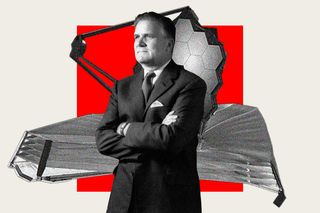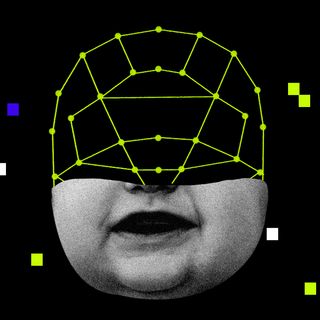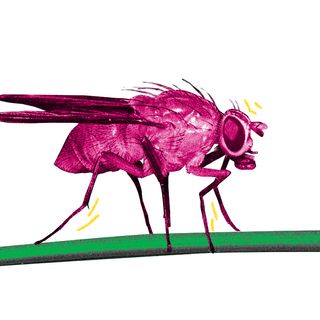
The James Webb Telescope Is Named After a Bigot. Its New Legacy Heightens the Need to Change Its Name
James Webb was known for being homophobic and discriminatory. Does he still deserve to be honored by science?

Images of the depths of the universe from the James Webb Space Telescope (JWST) released yesterdaybrought the world to a momentary standstill. These are awe-inspiring visuals of the cosmos like we’ve never seen them before, putting our place in this universe into perspective. The JWST is perhaps one of our most important achievements in science — showing how far we’ve come from merely being able to observe the skies with our eyes to peeking into distant reaches of galaxies — and back in time itself — through a telescope in space.
The telescope, however, is named for a man whose legacy stands to tarnish what this instrument could mean for us. James Webb was an administrator of NASA from 1961 to 1968. Webb oversaw the agency’s Apollo program that took Neil Armstrong and Buzz Aldrin to the Moon — this, along with his focus on science, led to him being honored with humanity’s best space telescope to date being named after him.
More than 1,200 people, including researchers and astronomers, who will use the telescope’s findings in their work, had opposed the move to honor him thus — citing his alleged track record of perpetuating a culture of homophobia within NASA. They brought a petition to rename the telescope before NASA last year, and the agency accordingly conducted an internal investigation. It concluded, however, that there was no proof to substantiate the allegations, and the petition was dismissed. This conclusion was made in one sentence, with no further documents provided to justify the decision — leading many astronomers to doubt the integrity of the investigation. “[A]stronomers opposing the name posit that he played a major role in setting the culture at the agency he presided over,” a report in Science notes.
Their suspicions weren’t unwarranted. Recent internal documents obtained by Nature showed how NASA was aware of the termination of a gay employee in 1963 because of his homosexuality, and that James Webb himself was complicit. The employee, Clifford Norton, filed an appeal in the court; documents show that the chief judge in the case cited the words of the person who fired Norton, who claimed that someone he consulted within the personnel office said that it was a “’custom within the agency’ to fire people for ‘homosexual conduct’,” the internal documents show.
Related on The Swaddle:
NASA Set to Launch Hubble Telescope’s Successor, Expected to Peer Into Universe’s Origins
Moreover, Webb was also complicit in what has come to be known as the “Lavender Scare” — a period in American history when government employees suspected of being gay were purged from employment. Webb donned many hats and was thus involved in this even beyond NASA — he served as the Undersecretary of State and allegedly oversaw the “purge” throughout the US government. “They [LGBTQ+ people] were, in the eyes of Webb and his allies on the right, akin to aliens from East,” notes historian Naoko Shibusawa.
“The gut-punch is in the outright refusal to hear the voices of queer astronomers,” Brian Nord, an astrophysicist, told Nature. “This is a refusal to confront history. If we can’t have that, how are we going to shed light on the oppression that people are facing?”
“I just don’t think that makes him the right choice for NASA’s premier science project more than 60 years later,” Rolf Danner, an astronomer and chair of the American Astronomical Society’s committee on sexual orientation and gender minorities in astronomy, told Nature.
As one of the biggest and most ambitious space projects globally — not to mention, a publicly-funded one at that — the JWST is accountable to people as much as people are indebted to it. The issue is to science debates what similar debates on problematic legacies have been to art for a long time: should we separate the science from the scientist? Arguably, not. Astronomers like Carl Sagan have represented what science should be: a project that advances humanity not just for what it teaches us about the world, but about ourselves, and how compassion takes us further in our shared pursuit for knowledge. When people involved in the science are complicit in bigotry, exclusion, and wanton discrimination — it doesn’t just hurt the people at the receiving end, it hurts science as a whole.
“As one of the people who has been leading the push to change the name, today feels bittersweet, I’m so excited for the new images and so angry at Nasa HQ,” Chanda Prescod-Weinstein, an assistant professor of physics at the University of New Hampshire tweeted earlier. The issue goes to show that science is never “neutral” or “objective” as it is mistakenly posited to be. Questions about who forms our knowledge systems, and even at whose expense, are integral to the story of our eons-old quest for learning.
It would do well, then, to remember in light of the Telescope’s images and the person from whom it derives its name, what Sagan himself said: “There is perhaps no better demonstration of the folly of human conceits than this distant image of our tiny world. To me, it underscores our responsibility to deal more kindly with one another, and to preserve and cherish the pale blue dot, the only home we’ve ever known.”
Rohitha Naraharisetty is a Senior Associate Editor at The Swaddle. She writes about the intersection of gender, caste, social movements, and pop culture. She can be found on Instagram at @rohitha_97 or on Twitter at @romimacaronii.
Related


Researchers Develop AI That Can Think Like a Human Baby
